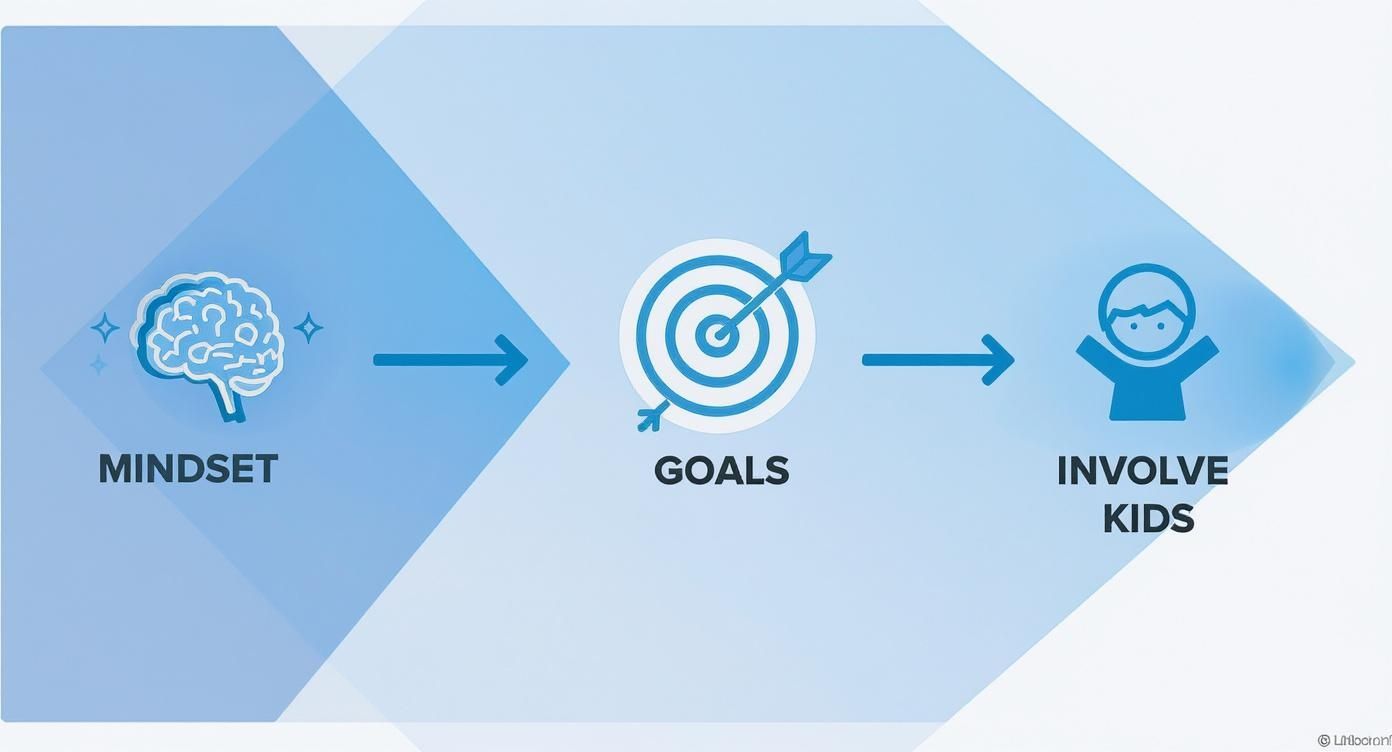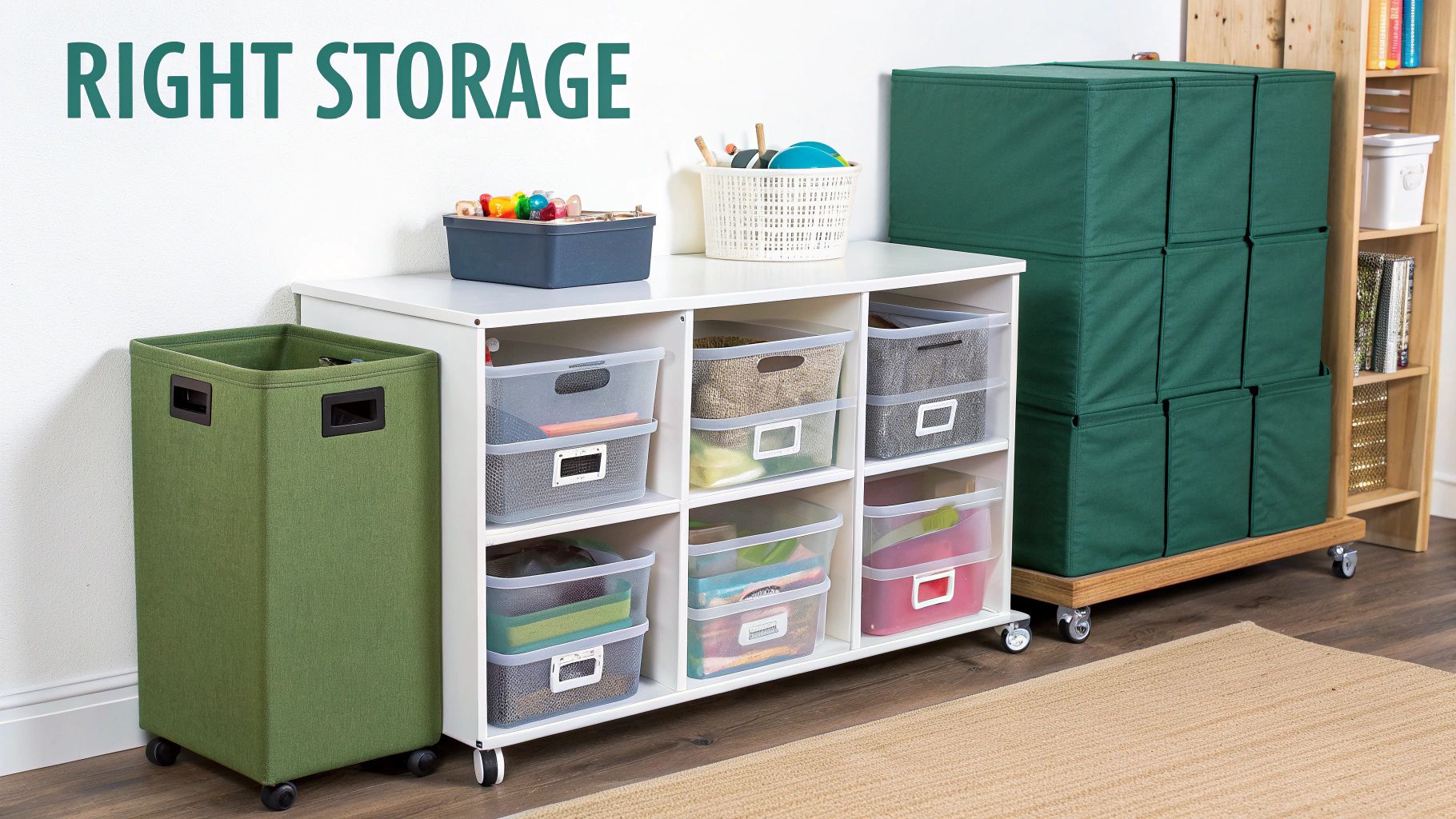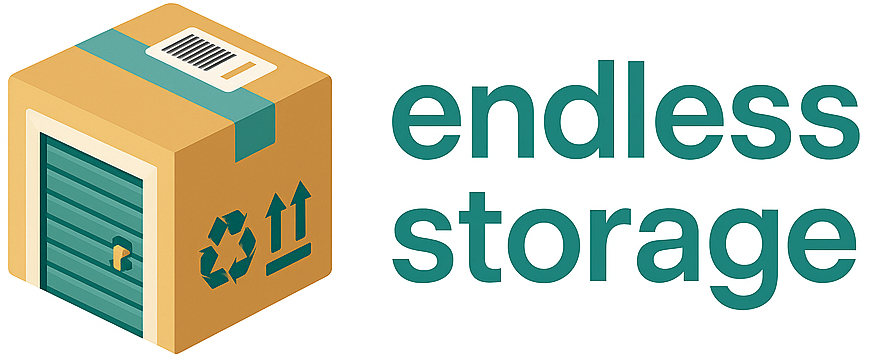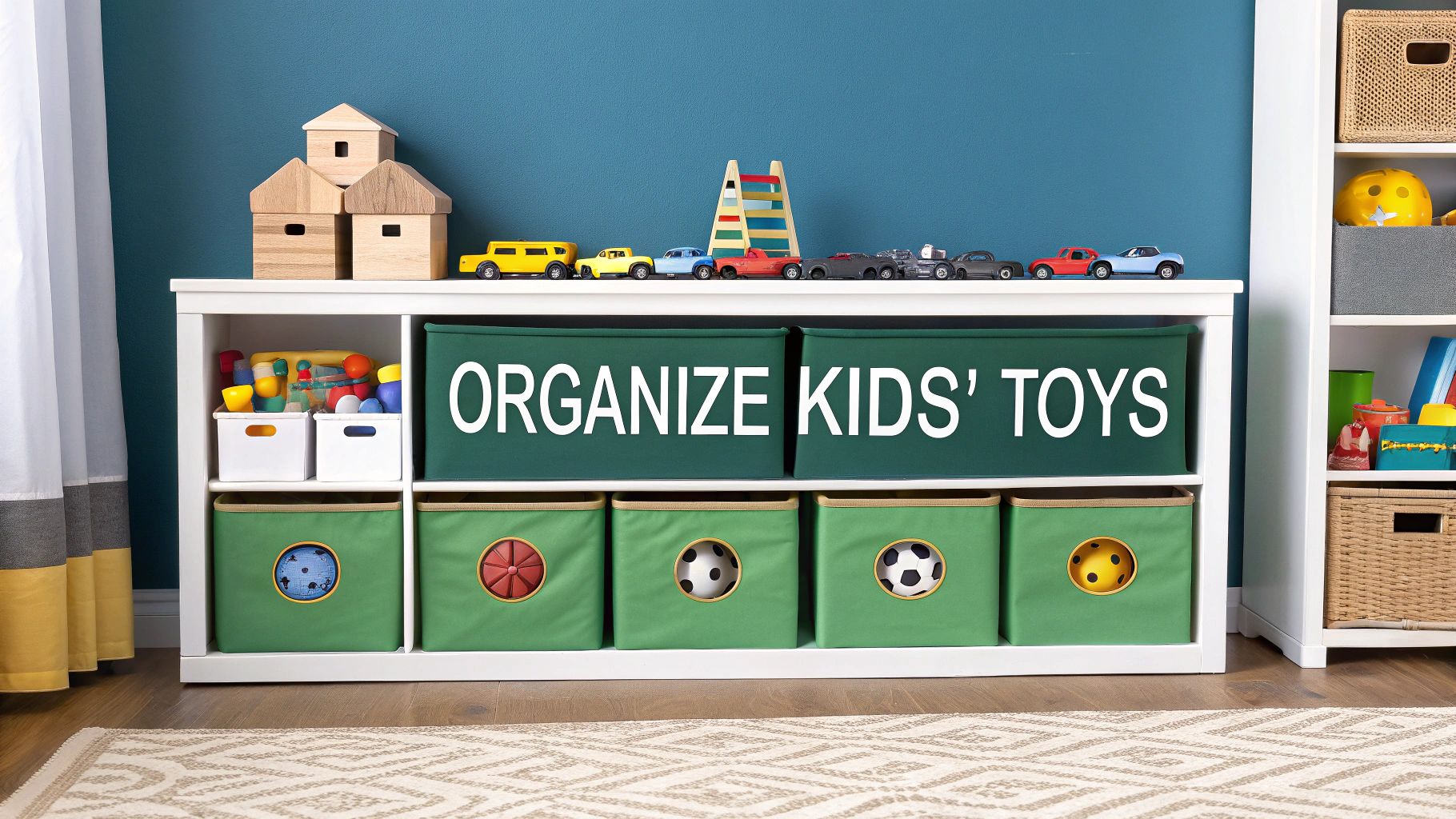That feeling of stepping on a LEGO brick in the dark is practically a parenting rite of passage. But let's be honest, the constant mess is more than just a minor annoyance. The secret to learning how to organize kids toys is shifting your mindset. This isn't about a one-time cleaning blitz; it’s about creating a sustainable, long-term system that actually makes cleanup easier for everyone.
Confronting Toy Chaos and Creating a Plan
Before you even think about buying a single storage bin, the first real step is to get your head in the game and come up with a solid plan. A messy playroom often feels overwhelming because it’s a symptom of a larger problem—not just untidiness, but a complete lack of a functional system. This chaos usually comes from a flood of well-meaning gifts, kids hitting new developmental stages, or simply outgrowing the storage methods you used to have.
And that feeling of being overrun with toys? It’s real. The global toy industry hit an estimated value of $113.94 billion, and it's projected to keep growing. A big part of this boom is parents investing in educational toys, which, ironically, need thoughtful organization to even be effective.
Setting the Stage for Success
To keep from getting completely burnt out, you have to set realistic goals. Instead of trying to conquer the entire playroom in one weekend, break the project down into smaller, more manageable chunks. Your main goal here is to create an environment that encourages your kids to play independently and makes cleanup feel intuitive for them.
A successful plan really boils down to a few key ideas:
- Establish a Clear Vision: What do you want this space to feel like? Aiming for peaceful, creative, and easy to maintain is a great place to start.
- Involve Your Kids Early: Even toddlers can help with simple tasks. Frame it as an exciting mission to build a "new and improved" playroom. This gives them a sense of ownership and makes them way more likely to help keep it tidy later on.
- Prepare for Tough Decisions: You're going to run into sentimental items and toys your kids swear they can't live without. Have a strategy ready before you start, like a designated memory box for special keepsakes. This stops you from getting stuck. For a more structured approach, our comprehensive decluttering checklist walks you through making these choices much easier.
The goal isn't just a clean room; it's about building lasting habits. An organized space reduces stress for everyone, fosters creativity, and teaches children valuable life skills about responsibility and taking care of their things.
The Strategic Decluttering Process
Alright, this is where the magic really happens. Let's move beyond just shuffling toys from one pile to another and adopt a focused strategy that actually cuts down on stress and shows you real progress. The best method I've found over the years is the ‘Four-Container Sort’. It gives you a simple, guilt-free framework for every single toy you pick up.
This system is a total game-changer, especially when you're facing those tough "what do I do with this?" moments. Just set up four boxes or designated areas and slap a label on each: Keep, Donate, Rotate, and Discard. This simple act forces you to make an immediate, intentional choice for each item.

As the graphic shows, getting your mindset right and setting a goal are huge. But the real key? Always, always include the kids in the process.
Using the Four Containers Effectively
Deciding the fate of each toy can be surprisingly emotional, especially with sentimental favorites or the things your kids swear they just played with yesterday. Here’s a breakdown to make it easier:
- Keep: This pile is exclusively for toys that see regular action. They should be in good shape and genuinely support your child’s current interests and development. Be brutally honest here—if it hasn't been touched in six months, it probably doesn't belong in the 'Keep' box.
- Donate: These are the gently used toys your child has outgrown but could still bring a ton of joy to another family. This is such a great way to teach kids about generosity.
- Rotate: This is your secret weapon against "I'm bored!" syndrome. Pack away good-condition toys that aren't top favorites right now. When you pull them out in a few months, they feel brand new again, which is a fantastic way to curb the constant demand for more stuff.
- Discard: This bin is for the casualties of playtime—toys that are broken beyond repair, games with critical pieces missing, and anything that’s just plain worn out. Let go of the guilt and just clear out the actual clutter.
Getting your kids involved (in an age-appropriate way) is so important. It gives them a sense of control and teaches them valuable lessons about letting things go. For a deeper look at this, check out our guide on how to declutter toys with your family.
To keep from getting overwhelmed, tackle this project in short bursts. I'm talking 20-minute sessions. Pick one small area, like a single shelf or one toy bin, and just focus on that. This approach turns a massive chore into a series of small, satisfying wins, making the whole thing feel less like a battle and more like a productive family mission.
Sorting Toys for Intuitive Play and Cleanup

Alright, you’ve pared down the mountain of toys. Now comes the part that makes all the difference: smart categorization. A jumbled toy box is basically a guarantee that every single toy will be dumped on the floor just to find one tiny car.
The secret is to sort the toys in a way that clicks with your child's brain, not just yours. Get on their level. Do they think in terms of "building stuff," "dress-up clothes," or "things with wheels"? When you group items this way, cleanup suddenly becomes a much more intuitive game for them. A great system means your kid can find what they want without your help and, even better, knows exactly where it belongs when playtime is over.
Create Kid-Friendly Categories
Forget complex, color-coded spreadsheets. We’re talking broad, simple groups that match how your kid actually plays. This is a huge piece of the puzzle for learning how to organize kids toys in a way that actually lasts.
Here are a few ideas that work in the real world:
- Sort by Type: This is the most classic method for a reason. All the vehicles go in one bin, building blocks get their own home, and dolls or action figures stick together. Simple and effective.
- Sort by Activity: Think about creating "kits" for specific things. A "craft bin" could hold crayons, paper, and safety scissors, while a "quiet time bin" might have puzzles and books ready to go.
- Contain the Chaos: For those toys with a million tiny pieces—I'm looking at you, LEGOs and doll accessories—use smaller zippered pouches or fabric bags inside a larger bin. This is the only way to stop those tiny shoes and tiaras from being lost forever at the bottom of the toy chest.
A well-organized system empowers children. When they can easily see and access their toys, it encourages more focused, creative play and reduces the overwhelming feeling of a messy room.
To get you started, here’s a quick reference guide for grouping some of the most common toy culprits.
Toy Category Sorting Cheatsheet
Once everything has a home, the final touch is making it crystal clear where that home is. This is where labels become your best friend. For little ones who can't read yet, a picture of the toy on the bin is way more effective than a word. This simple visual cue turns cleanup into a simple matching game.
You can dive deeper into the best way to label storage bins to make your system completely foolproof and kid-friendly.
Choosing Storage That Works for Your Family

Alright, you've sorted everything into neat little piles. Now comes the fun part: finding the perfect home for it all. The right containers are the backbone of any good toy organization system, and this is where you can really set yourself up for long-term success.
The goal isn't just to hide the mess. It's about creating a system that your kids can actually use themselves. We're looking for solutions that are safe for little hands, easy to access, and won't make your living room look like a preschool.
Think about how your child plays. Low, open shelves are a game-changer because they invite kids to put things back where they belong. They can see exactly where the block bin goes. That simple choice can honestly make a huge difference in your daily cleanup battle.
Selecting Smart Storage Solutions
The world of toy storage is huge, and it's easy to get lost in all the options. My advice? Focus on function over whatever’s trendy this month. If you need a good starting point, this comprehensive guide to toys storage organizers is a great resource for breaking down what might work best for your family.
Here are a few of my go-to, tried-and-true options:
- Cube Shelving: A classic for a reason. They’re versatile, budget-friendly, and create a really clean look when you pop in some fabric bins.
- Clear Stackable Containers: These are lifesavers for stopping the "dump everything out to find one thing" habit. Kids can see what’s inside, so they're way less likely to empty the whole bin on the floor.
- Rolling Carts: Absolutely perfect for art supplies or a big LEGO project. You can just wheel the whole station from the playroom to the kitchen table and keep all those tiny pieces contained.
- Vertical Wall Storage: When you're tight on space, going vertical is a brilliant move. Wall-mounted shelves or pocket organizers get toys off the floor and make use of every last inch.
This kind of smart, segmented storage is a big deal everywhere. In Europe, for example, which makes up about 21% of the global toy market, there's a huge emphasis on STEM and educational toys. That means parents there are all about multi-compartment organizers and stackable boxes that keep those complex building sets together.
Key Takeaway: The best storage system is one your child can use independently. Prioritize accessibility and visibility—if they can see it and reach it, they are far more likely to use it correctly.
And don't be afraid to get creative! I've seen people use repurposed shoe organizers for dolls, wicker baskets for stuffed animals, and even plastic dish tubs for sensory play items. For more clever ideas, check out our guide covering dozens of unique toy storage ideas.
Maintaining a Clutter-Free Play Space
Getting your kids' toys organized is a fantastic feeling, isn't it? But the real challenge is keeping them that way. It's not about achieving perfection overnight; it's about building simple, sustainable systems that stop the toy avalanche before it starts. The goal is to make tidiness the new normal.
One of the most effective tricks I’ve seen is implementing a toy rotation. Pack away a portion of the toys—maybe a third of the collection—into a bin and store it out of sight. Every few weeks, swap the stored toys with some of the ones currently in the playroom. It’s a simple move that keeps playtime feeling fresh while instantly cutting down on the daily clutter you have to manage.
Building Sustainable Tidy Habits
When it comes to learning how to organize kids toys for the long haul, consistency is your best friend. Instead of letting it pile up until you can’t take it anymore, it’s much easier to weave small tidying routines into your family's daily life.
A great place to start is with a "5-Minute Tidy" before bed. Just put on a fun song and have everyone pitch in to put things back where they belong. It’s short, totally manageable, and teaches kids that cleanup is a normal part of wrapping up an activity. And if you're looking to bring that same sense of calm to your own spaces, check out these helpful pro tips for a clutter-free room.
A "one in, one out" policy is an absolute game-changer for birthdays and holidays. Before a new toy finds its permanent home, have your child help choose an old one to donate. This simple rule prevents the slow creep of clutter and teaches a valuable lesson in mindfulness.
This is especially important now, with toy sales for categories like building sets and games constantly on the rise. Managing the influx of new stuff is more critical than ever.
Ultimately, keeping an organized space is all about finding a rhythm that works for your unique family. For a deeper dive into making your entire home a more peaceful place, explore our other posts on clutter-free living tips.
Of course. Here is the rewritten section, following all your requirements.
Common Questions About Organizing Kids Toys
Even with the best system in place, some toy situations are just tricky. Let's be real—the day-to-day chaos is where the real challenge lies. Here are some of the most common questions I get and the practical, real-world answers to help you troubleshoot.
How Do I Get My Kids to Actually Help?
The secret is to make cleanup part of the daily rhythm, not a dreaded punishment. When it’s as routine as brushing their teeth, you’ll get a lot less pushback. Clear bins with picture labels are a game-changer here; they empower little ones to know exactly where everything goes without needing to ask you.
It also helps to make it fun. We love a good "beat the clock" challenge or blasting a high-energy cleanup song. Most importantly, model the behavior yourself. When they see you putting things away, they’re more likely to join in. Start small with super specific tasks, like, "Can you find all the red blocks and put them in this bin?" and shower them with praise for their effort.
What Is the Best Way to Organize LEGOs?
I’m going to be honest: for most families, trying to sort LEGOs by color or original set is a one-way ticket to insanity. Don't do it to yourself. A far more practical approach is to use shallow, under-bed storage containers or large, flat bins. This lets kids spread the pieces out to see what they have without dumping the entire collection on the floor every single time.
If you have smaller collections or special sets you want to keep intact, zippered pouches or those small, clear tackle boxes are fantastic. They’re perfect for preventing those crucial tiny pieces from getting lost in the chaos of a deep toy chest.
A major toy declutter should happen at least twice a year. I always recommend doing it right before a birthday and again before the end-of-year holidays. This proactive approach keeps the incoming flood of new toys from becoming completely overwhelming.
How Do I Handle Sentimental Toys?
You absolutely do not have to get rid of every sentimental item. The key is being intentional and selective. Designate one special "keepsake bin" for each child. This is their treasure box. Let them be part of the process, choosing a few truly meaningful items that represent a specific stage of their childhood.
Once the bin is full, the rule is simple: if a new item goes in, something has to come out. This simple boundary is incredibly effective. It allows you to honor those cherished memories without letting them take over your entire home.
Ready to reclaim your space without the hassle of a traditional storage unit? Endless Storage offers a simple, stress-free solution. We deliver storage boxes right to your door, pick them up when you're ready, and return them whenever you need them. Learn how Endless Storage can help you declutter today!
Frequently Asked Questions
Unveiling the Secrets to Effortless Storage
Endless Storage is available nationwide. You pick a plan, tell us where to pickup, and we'll send a UPS van to collect, whichever state you're in.
Your shipping label will be sent to your email within a few minutes, if not instantaneously. It can also be accessed through your customer profile.
Your box will be shipped to one of our climate controlled self storage facilities in our closest self storage facility. Our manager will accept your package, notify you that your box has been received, and securely stored. Only our managers will have access to Endless Storage boxes.
Email us at admin@endless-storage.com click to live chat with us, or send us a message below.
Never! We're committed to transparent pricing with no surprises. You'll lock in your rate with no hidden fees and no long-term contracts.
Fast access guaranteed! Your boxes will arrive at your doorstep within 48 hours of requesting them back. Need to check on delivery? We provide tracking information for complete peace of mind.
Totally flexible! Store month-to-month with no long-term commitment and cancel anytime.
Everything's online! Use your account dashboard to:
• Set up automatic monthly payments
• Request box returns
• Update your address
• Order additional boxes
• Track shipments
Your boxes are insured up to $100 each. Our customer service team will help you file any necessary claims and resolve issues quickly.
Don't worry – we'll email you right away if there's a payment issue. Your items stay safe, though you may have temporary service interruption or late fees until payment is resolved.
When you request our free storage kits, you'll have 30 days to send in your boxes to activate your 3 months of free storage. Think of it like starting a gym membership – your activation window begins when you receive your kits, and your full free trial begins once you send in your first box. During your free months, you'll experience our complete storage service at no cost.
Your 30-day activation window begins when you receive your storage kits. We'll send you an email confirmation when your kits are delivered, marking the start of your activation period.
If you haven't sent any boxes for storage within your 30-day activation window, your free trial will expire and we'll begin charging the regular monthly rate of $9.99 per box. This helps ensure our storage kits go to customers who are ready to use our service.
A box costs $9.99 per month to store (plus sales tax). This price includes free shipping for standard boxes under 50 lbs. and smaller than 16"x16"x16"
Log into your Endless Storage account, locate the box you would like returned, and simply click Return My Box.
Yes, each box stored with us is insured for up to $100 throughout transit as well as the duration of storage within our facilities.
Your box will be at your doorstep within 48 hours of you requesting it back.
Store 10+ boxes? We'll pick them up for free! After your purchase, we'll contact you to schedule a convenient pickup time and arrange UPS collection.
We trust UPS with all shipments, and every box includes $100 insurance coverage. You'll receive tracking information to monitor your items' journey.
Yes! Visit any of our locations by appointment. Just bring a photo ID matching your customer profile.
For everyone's safety, we can't store hazardous materials, firearms, or perishables. All items must fit within our standard boxes.
It's easy! Order your storage kit online, and we'll ship it to you within 1-2 business days. Your shipping labels will be emailed instantly and available in your account.
We're here to help! Email us at admin@endless-storage.com, use our live chat, or send us a message through your account.
To cancel your storage service with Endless Storage, please email your cancellation request to admin@endless-storage.com. Our team will process your request within 2 business days and confirm your cancellation via email.
We understand packing takes time. However, to maintain your free trial benefits, you'll need to send at least one box within the 30-day activation window. If you need more time, you can always start with one box to activate your trial and send the rest later. You can always reach out to admin@endless-storage.com if you have any issues or concerns.
When you request our free storage kits, you're starting a 30-day window to begin using our storage service.
To avoid any charges, simply send at least one box for storage within 30 days to activate your 3-month free trial. If you decide not to use our service and don't send any boxes within the 30-day window, a one-time $50 fee will apply to cover the costs of materials and shipping. This helps ensure our storage kits go to customers who are ready to use our service.
Think of it like reserving a hotel room – we're setting aside space and sending specialized packing materials for your use. The fee only applies if you request materials but don't begin storage, similar to a hotel's no-show charge.

